With 175 State Parks and 3 National Parks, hiking in Florida couldn’t be any easier! When was the last time you really explored the great outdoors? When was the last time you took the time to appreciate nature?
Hiking should be the next hobby you adopt! When you combine the fresh air and Florida sunlight, aerobic walking, and proximity to nature, you’ll compensate for many of the physical and mental stresses you encounter in a work week.
Research also shows that hiking has mental benefits as well as physical ones! Science has proved that those suffering from depression coped better when taking walks or hikes in nature than those who just walked around a shopping mall.
Even if you just need to clear your mind, a hike can get you out of your head. When you subconsciously observe the complexity of nature, you lower your stress allowing you to think more clear. Your next “aha!” moment is literally steps away.
Hiking won’t break your wallet either. Other recreation like kayaking, rock climbing, and scuba diving can lead to expensive equipment and complicated rentals. The only gear you need on a hike? A pair of good shoes/boots, a water bottle, and maybe a small backpack.
If you’re still apprehensive, keep in mind that all hiking is not like climbing Mount Everest! Trails for hiking in Florida come in all levels of difficulty. Your adventure can be as simple as less than a mile on a boardwalk or jumping from rock to rock on river rapids.
When you explore the best hiking trails in Florida, no two trails are similar. From beaches to sinkholes and forests to swamps, Florida’s vast ecosystems provide changing backdrops no matter what your preference!
Lace up your boots, grab some bug spray and water, and discover the best Florida hiking trails. We’ve made a list of our favorites so all you have to do is explore! Happy trails!
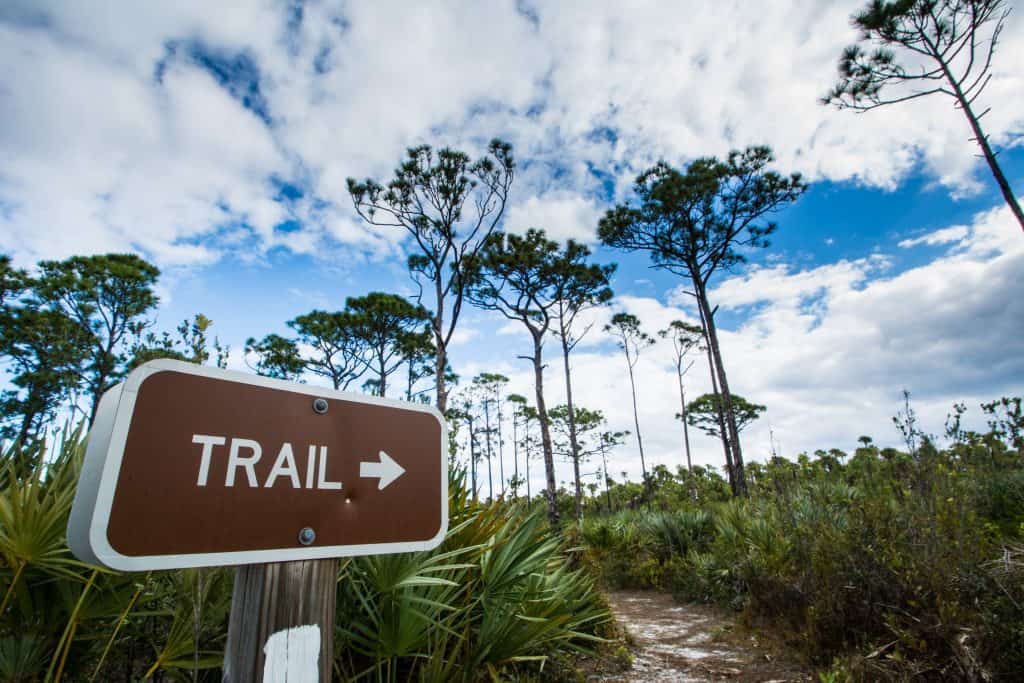
15 Scenic Trails For Hiking in Florida
Florida Trail (Milton)
While the Florida National Scenic Trail runs over 1,000 miles throughout the state, we’re going to focus on our favorite stretch in Blackwater River State Forest. Here you’ll explore Atlantic white cedar and longleaf pine forests near the Alabama border.
In Milton, this stretch of trail approaches the Alabama State Line and the greater Eastern Continental Trail. At 7.3 miles, Juniper Creek makes an easy day hike! Make sure to wear neon orange during hunting season and shoes that can get wet.
Start your hike from the recreation area inside the park. You’ll want to follow the floodplain forests along the river. After passing through wet and muddy spots, you’ll enter an extensive longleaf pine forest.
As the trail swings out closer to Juniper Creek, keep your eyes peeled for mountain laurel with sparkleberries and magnolia. Listen for the sounds of the fast-moving stream trickling through the rugged terrain.
Watch for a worn path several miles in that leads down to Red Rock Bluffs. As close as you’ll get to the Grand Canyon in Florida, clay cliffs erode into the basin of Juniper Creek.
From here, you can either head a half mile up to the next trailhead at Red Rock Road, or turn and go back the way you came!
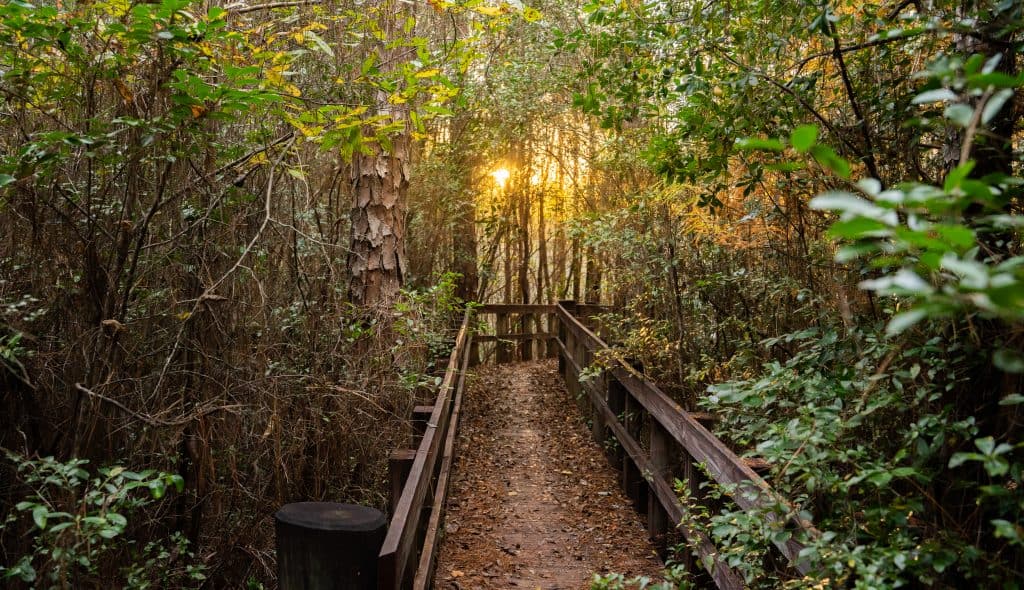
Dune Trail at Blowing Rocks (Jupiter)
Near Hobe Sound on Jupiter Island, one of the state’s prettiest islands, you’ll find one of the most unusual trails for hiking in Florida. With one of the most dramatic shorelines, Blowing Rocks offers sea caves and bluffs.
At 2.5 miles, you’ll explore a rocky shoreline featuring a gorgeous limestone terrace where the sand meets the sea. We recommend checking the tides beforehand so you can pick what you want to see.
At high tide, you can see the frothing blowholes. At low tide, you’ll have a greater opportunity to explore the mysterious sea caves. Watch out for sea urchins!
From the trailhead, you’ll embark on a sandy trail heading towards the sea. Sea Grapes create a long tunnel. In summer, their ivory blooms glisten and edible grapes turn red in fall in Florida.
As you emerge on the beach, the Atlantic roars and crashes into the eroding rocks of the Anastasia limestone. If visiting at low tide, explore the caves. A natural labyrinth, some caves are tall enough to stand in, with natural skylights above.
As you continue north along the path, the rock underneath becomes eroded and uneven. Through the twisted formations in the weathered rocks, blowholes have been created. On stormy days, waves crash up through the caves and soar as high as 50 feet in the air.
As you head back the way you came, avoid small roped-off areas. These are are sea turtle nests, where more than 600 turtles lay their eggs during the summer!
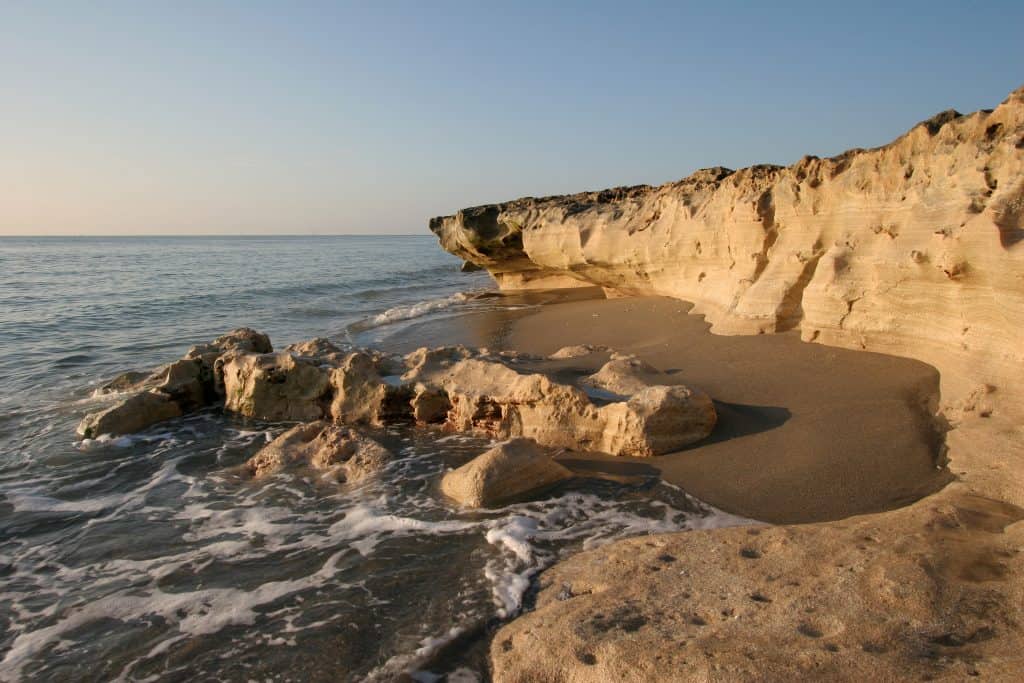
Black Rock Trail (Jacksonville)
Just off the coast of Jacksonville, you’ll find Big Talbot Island, one of Florida’s hidden gems. You might think you’re in Hawaii with its white sands, rocky shorelines, and saw palmettos. The unique geological features create one of the best trails for hiking in Florida!
Just over a mile each way, Black Rock Trail is easy enough for novice hikers. Because access to the island is free, we recommend going on a weekday or in the early morning on weekends. Parking is limited and may be crowded.
Find the entrance to Black Rock Trail by following the bike path south from the parking lot. Here, the trail is very wide and the path is thankfully shaded. At the fork, keep right.
You’ll emerge just above the shoreline. Here’s the tricky part. Because the shoreline has eroded, there’s no foolproof way to get down there easily. Carefully use the tree roots as footholds as there are no staircases.
Your reward awaits at the coastline. The black rocks you see are actually compressed sand, whose surface changes upon every visit. At low tide, you can walk half a mile in either direction.
Before climbing back to head to your car, look out for fallen, sun-bleached trees. This is Boneyard Beach, one of Florida’s most hauntingly beautiful attractions. This is a preserve, so don’t take anything with you except pictures!
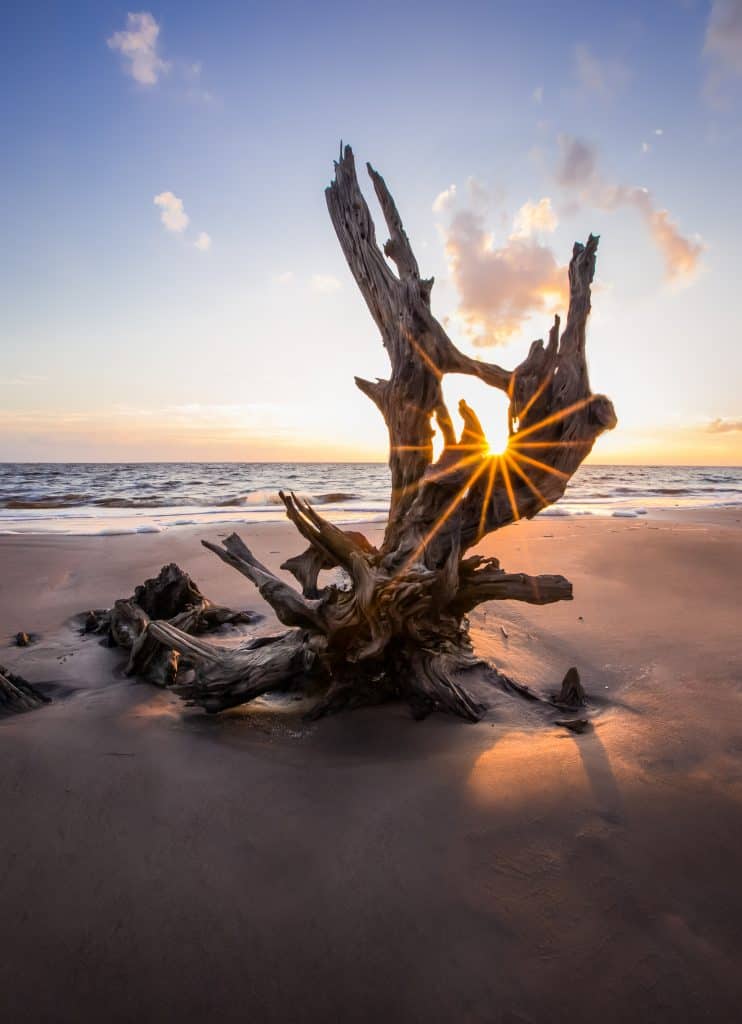
Jupiter Creek Nature Trail (Ocala)
In lovely Ocala, you’ll find the world’s largest scrub forest in the Ocala National Forest. Hidden between the trees, you’ll find a playground of crystalline waters along the Jupiter Creek Nature Trail, one of the best Florida hiking trails.
Winding between Jupiter Springs and Fern Hammock Springs, this trail is only 1.4 miles. Very easy for novice hikers, the trail is also wheelchair accessible. Make sure to wear a swimsuit under your clothes to take a dip in one of Florida’s natural springs.
From the parking lot, find the trailhead behind an old mill. Below the “nature trail” sign, you’ll see tiny spring boils bubbling up, a taste of what’s yet to come.
As you walk, you’ll cross a bridge onto a boardwalk through a lush subtropical hammock. Look out for blonde squirrels and dense areas of marsh fern and sword fern.
Finally, you’ll reach Fern Hammock Run, which flows toward the larger Jupiter Run. At the intersection, turn left to cross a bridge over the waterway for a close-up view.
The deep aqua waters run clear with royal ferns jutting out from rocks like giant feather dusters. You’ll get lost looking at the spring bed floor, the rushing water creating shapes and patterns with a soft, hypnotic trickling sound.
In the winter, you might see wild manatees seeking warmer waters in the spring. Once you’ve had your fill of the sights, turn back the way you came and head back to the recreation area to take a well-deserved swim!
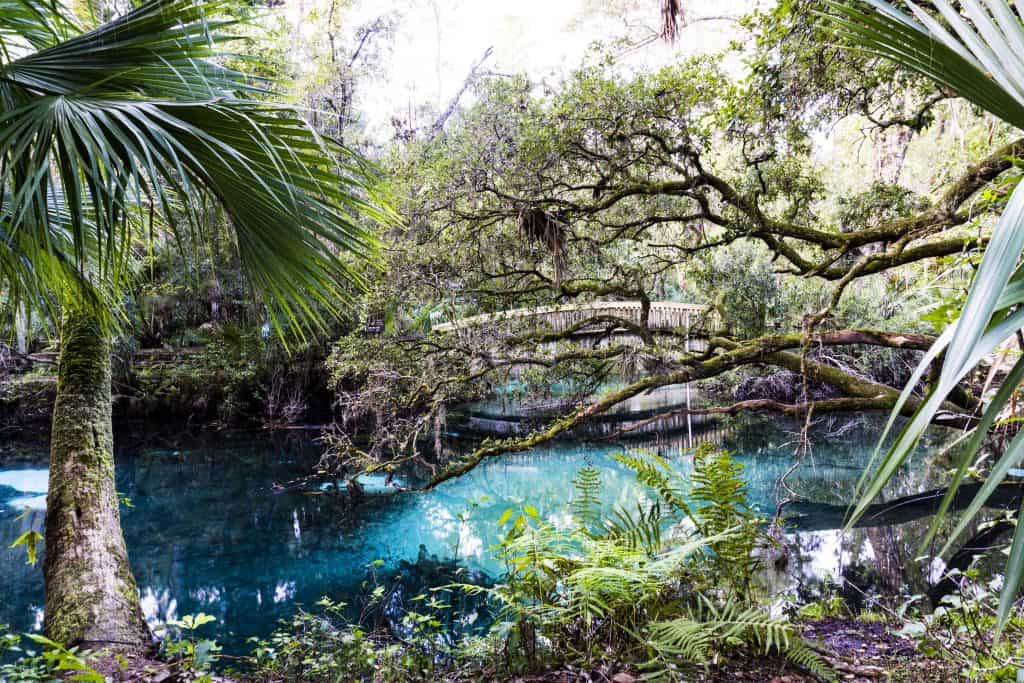
Bok Tower Gardens (Lake Wales)
Bok Tower Gardens, the perfect day trip from Orlando, has been referred to as “a spot of beauty second to none in the country.” The gardens, with the enormous Bok Tower at its center actually has two of the most beautiful trails for hiking in Orlando.
In Lake Wales, just outside of Orlando, Bok Tower resides at Mountain Lake Colony, the steepest hill in Florida. At the center of the trails lies the Carillion Tower with bells inside that can be played like an instrument. Listen for music at 1 and 3 PM.
The Preserve Trail is the longer of the two, at 1.5 miles. Here you’ll learn about Florida’s most endangered ecosystem. Paved with pebble rock from phosphate mines, you might see tiny fossils at your feet!
The Pineridge Trail is slightly shorter at 3/4 mile, taking you through the endangered longleaf pine forest. The trail begins near Window by the Pond and ends at the Visitor Center and parking lot area.
On the Pineridge Trail, you’ll notice burned out portions of the the trail. This is because prescribed burns are necessary to keep out invading evergreen oaks.
Here you’ll also be able to spy on many endangered Florida native animals. Educational signage will teach you about the Gopher tortoise, the Eastern indigo snake, Gopher frogs, and the Florida Mouse.
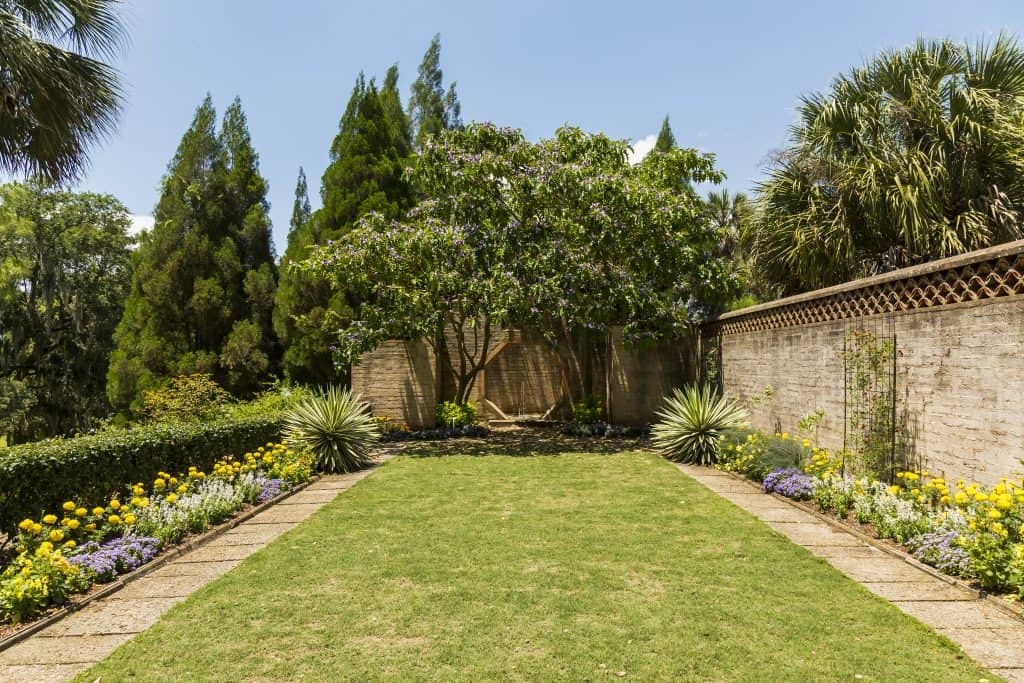
Citrus Hiking Trail (Dade City)
One of the best things to do in Dade City, the Citrus Hiking Trail demands a lot of those who brave it. Over 39 miles, hikers spend four days traversing rolling sandhills, rock-strewn footpaths, and steep descents.
The Citrus Hiking Trail earns itself the title of the most rugged of trails for hiking in Florida. Although it presents a challenge, the trail remains easily followed thanks to regular grooming and clearly-defined footpaths.
Begin by parking your car at Holder Mine, where you’ll pay $5 per day while backpacking. With few water sources, consider this a dry trail and plan accordingly.
If you don’t want to tough it out in nature over four days, never fear! Check maps for forest roads to break up the trail into a comfortable day hike. You can always come back and tackle more each time you visit.
On your first and second day, you’ll pass through groves of live sand oaks and Bull Sink. Make your camps at the Dixieland Equestrian Trail and Taylor Campsites respectively.
On day three, you’ll leave the denser forest and encounter a reliable water source at Stage Pond, where stage coaches once stopped. Make your camp at Mutual Mine on soft pine needles.
On the last day of your hike, you’ll move into open grasslands through sandy hills. Make sure to stop at the biggest cave in Florida before looping back to Holder Mine to complete the hike.
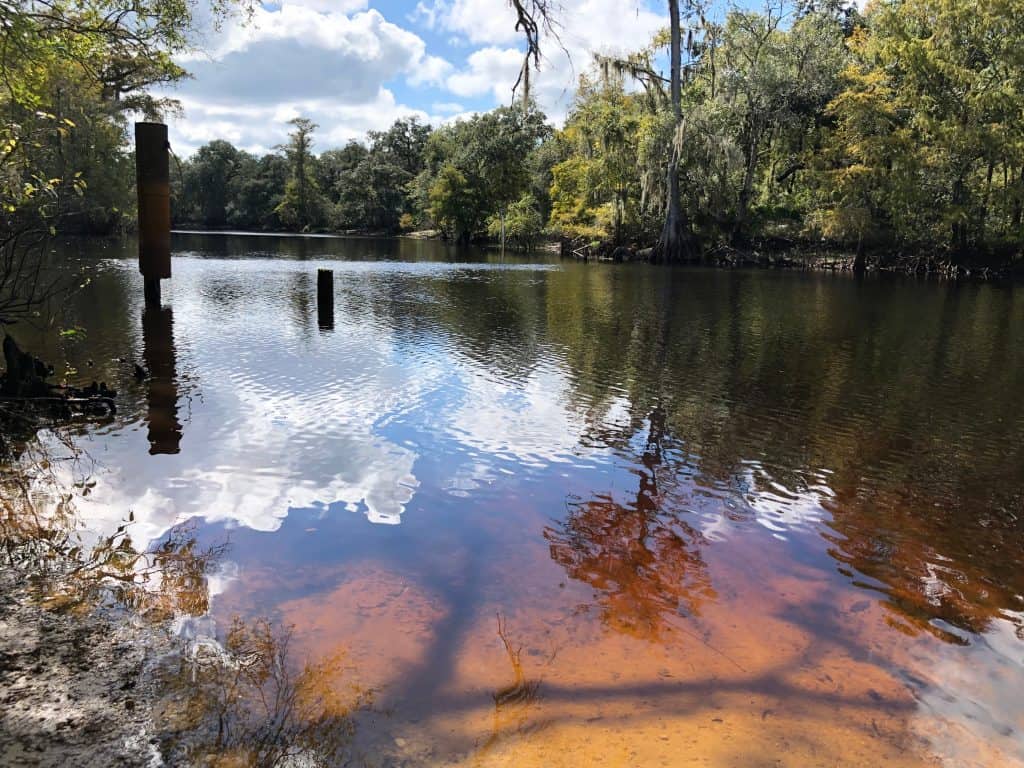
Myakka Canopy Walk (Sarasota)
One of the best things to do in Sarasota, this Florida hiking trail is like no other. Found in Myakka River State park, you’ll be afforded sweeping views of the live oak canopy and a panorama of the Myakka River basin.
Before ziplining became all the rage, the Myakka Canopy Walk was the first of its kind in Florida. Designed after the ones used by the scientists in South American rainforests. This trail may be short, but it is unique and family-friendly, suitable for kids!
From the parking area, turn right to approach the canopy walk through large oak hammocks. Step gingerly as the walkway rolls forward like a wave as you cross. Here, you’re eye-level with bromeliads and resurrection fern.
Once you cross, climb up to the 76-foot high observation tower. Your expansive view is mostly of forest, but if you look to the left, you can spy the Myakka River snaking up to Myakka Lake.
Climb back down to return to the parking lot or continue on the William S. Boylston Nature Trail. On a path laden with resurrection fern and bromeliads, you’ll come to a boardwalk with airplants and a bench on the marsh.
Keep looking up to see more bromeliads, the sun darting through them to create orange and pink light. Make sure to keep an eye out for the limbs of a live oak forming a heart.
Past the willow marshes and natural statues of dead oaks, you’ll reach a trail junction that connects back to the canopy walk. Head past where you started to reach the parking lot!
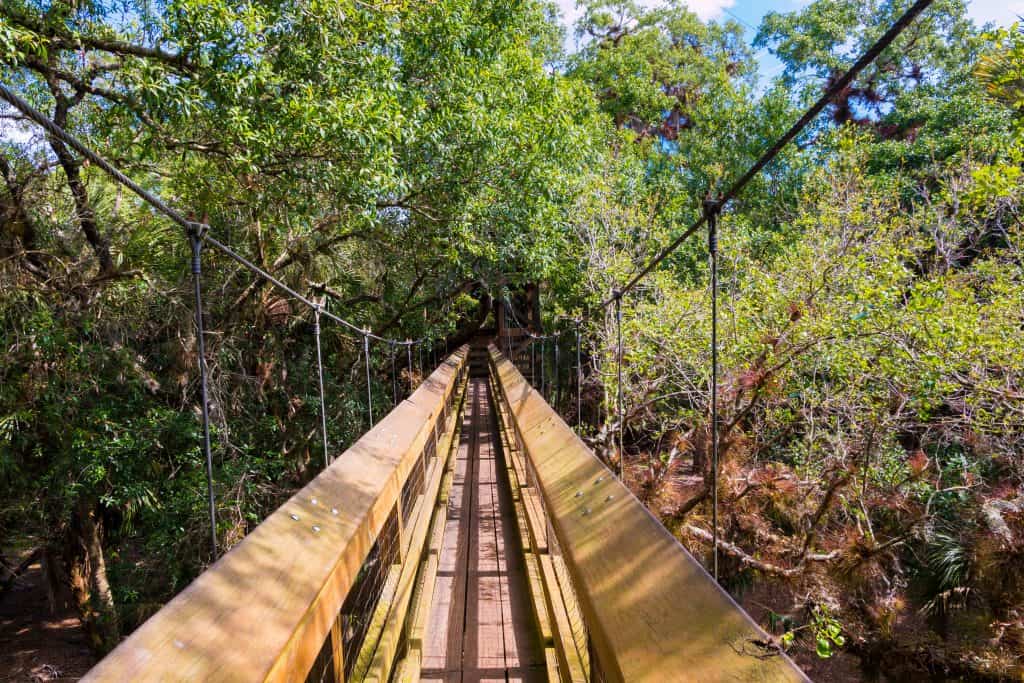
Green Trail (Orlando)
In Lake Nona, you will find one of the best trails for hiking in Orlando. The Green Trail, while catering to horses, is also welcome to hikers of the human variety!
In the center of the Split Oak Forest, the trail will take you past the park’s namesake. A live oak tree stands over 200 years old and has been naturally split down the middle and survived.
At 3.4 miles, the Green Trail is moderately trafficked. Even if you don’t take the Green Trail, with the help of a park map, you’ll be able to construct your own path to create a shorter or longer hike.
You’ll find the trailhead along Moss Park Road at the Park’s entrance across the campground. Follow the orange markers through a forest of longleaf pines and oaks.
On the left, you’ll come to Lake Hart Spur. If the lake waters are high, you’ll find gopher tortoises and many other native Florida animals.
Follow the ancient live oaks to come to an observation deck overlooking Bonnet Pond. Beautiful lily pads float over the water. Afterward, the path curves to the right to reach the main attraction.
As you approach the oldest split oak in the park, admire its cave-like trunk. Stay alert and you’ll see a half-dozen more just like it, but his one here is the oldest, and the park’s namesake.
Sadly, Split Oak Forest and the Green Trail are in danger of being destroyed for the construction of a major highway. Join the fight and get involved.
River Rapids Nature Trail (Tampa)
One of the best Tampa attractions, Hillsborough River State Park is one of the area’s most beloved. A family-favorite because of its rapids (yes, rapids!) the River Rapids Nature Trail is one of the best trails for hiking in Tampa!
Running 5.8 miles, the River Rapids Nature Trail should be of no difficulty for intermediate hikers. Even if you’re a novice, parts of the trail may be challenging, but as a whole the trail remains very accessible.
Start at the “nature trail” sign and pass the Civilian Conservation Corps shelter made of logs. The water rushes under the overlook, trickling across Suwannee limestone.
Cross the suspension bridge to head upstream through a wild citrus grove. As you wind through hickory trees, you’ll see cabbage palms dense with lichens.
Another bridge takes you to a damp area of the trail and past towering oaks to reach the river bluffs. Admire the rapids as you walk upstream before retracing the route back to your car!
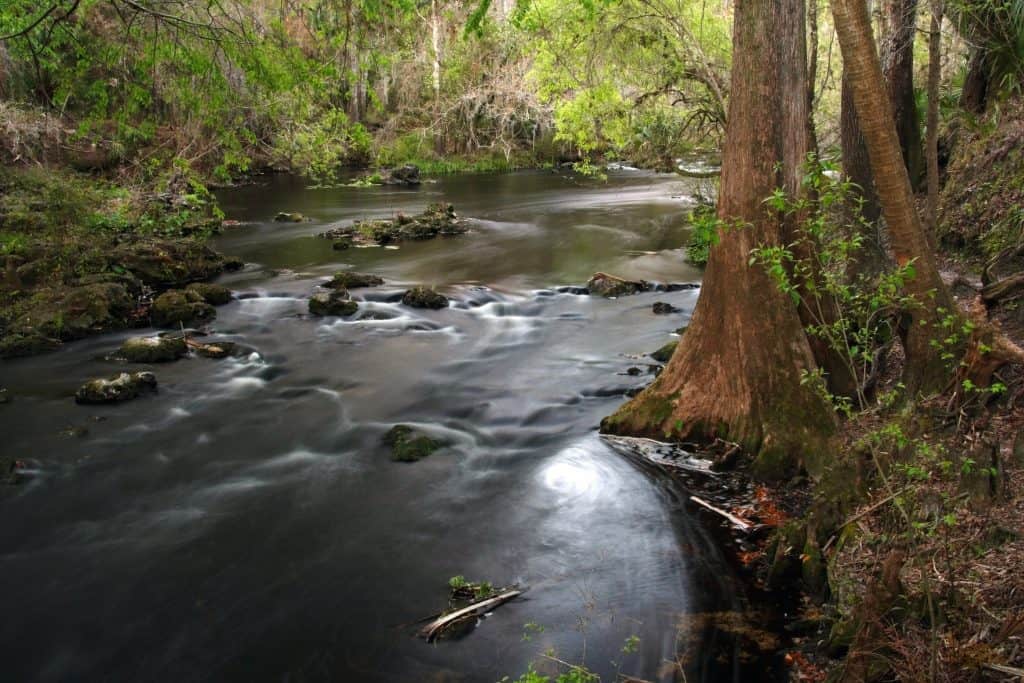
Black Creek Trail (Miami)
With many attractions in Miami, it is easy to get caught up in the hustle and bustle of downtown. When you need to escape from it all, head to Key Biscayne National Park, where you’ll find one of the best trails for hiking in Miami.
Black Creek Trail affords some of the most beautiful vistas in all of Miami. While also a great trail for hiking in Florida, many of its nine miles are paved, perfect for rollerblading and biking. The trail provides no shade, so sunscreen is essential.
Start in Black Point Park and Marina. From here, you can follow the Biscayne Trail along the canal. Here, you’ll also find one of the best restaurants in Miami, a boat launch, picnic pavilions, and a fishing jetty.
As you keep on, you’ll pass the canal with vultures, iguanas, and other wildlife. As you pass 176th Street, you’ll approach Larry and Penny Thompson Park! Relax on the beach and enjoy your reward in the warm waters of Miami.
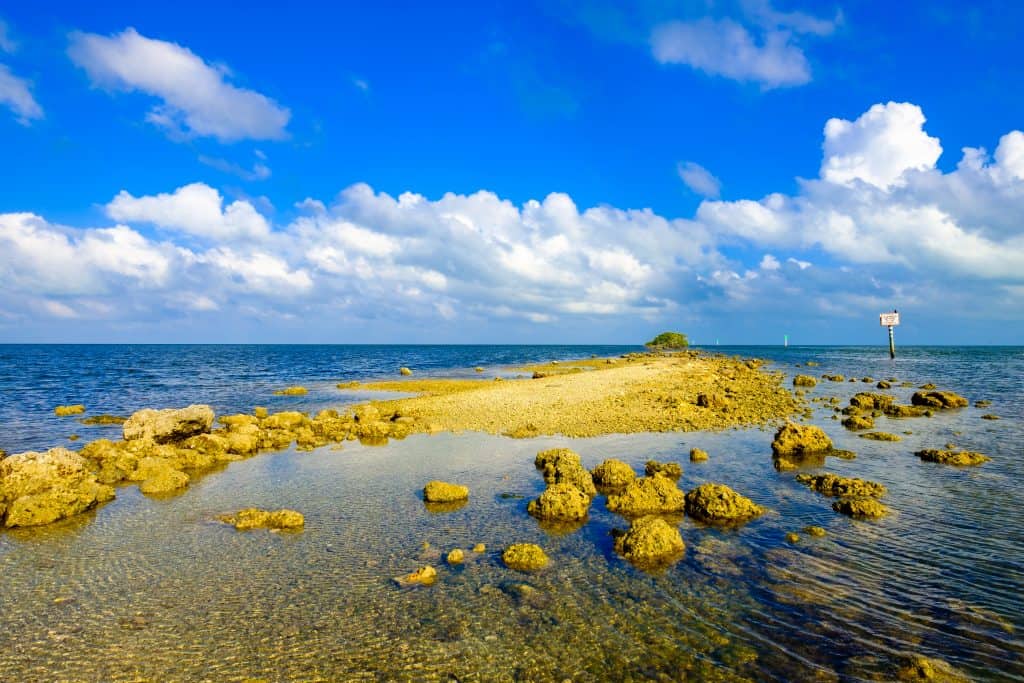
Old Bahia Honda Bridge Trail (Florida Keys)
The original Bahia Honda Bridge remains standing today, a testament to the innovative engineering of yesteryear. From this trail, you’ll take in the most beautiful panoramic vistas.
The rich history makes this one of the best trails for hiking in Florida. The crumbling remains of the highway deck harken back to Henry Flagler’s railroad days. Find the entrance to the trail near the parking area in the marina.
At the beginning of the trail, you’ll find a cluster of interpretive signs. Along with maps of the area, they recount the history and provide insight to the ecosystems in Bahia Honda.
Walking along the path, a gradual ascent elevates you gently towards the bridge. Notice the remains of the sea grape tunnel completely destroyed by Hurricane Irma. The regrows continues to be inspiring.
As you step out onto the bridge, the railroad is under your feet. Here, you’ll get stunning views of the Bahia Honda Bay. Look out for anglers and tour boats headed out for dives at Looe Key.
After you make the descent back down, get a closer view of the bridge from the Bahia Honda Beach Walk. As the trail takes you to the opposite side of the channel on Scout Key, you can get a better view of the arch work and girders.
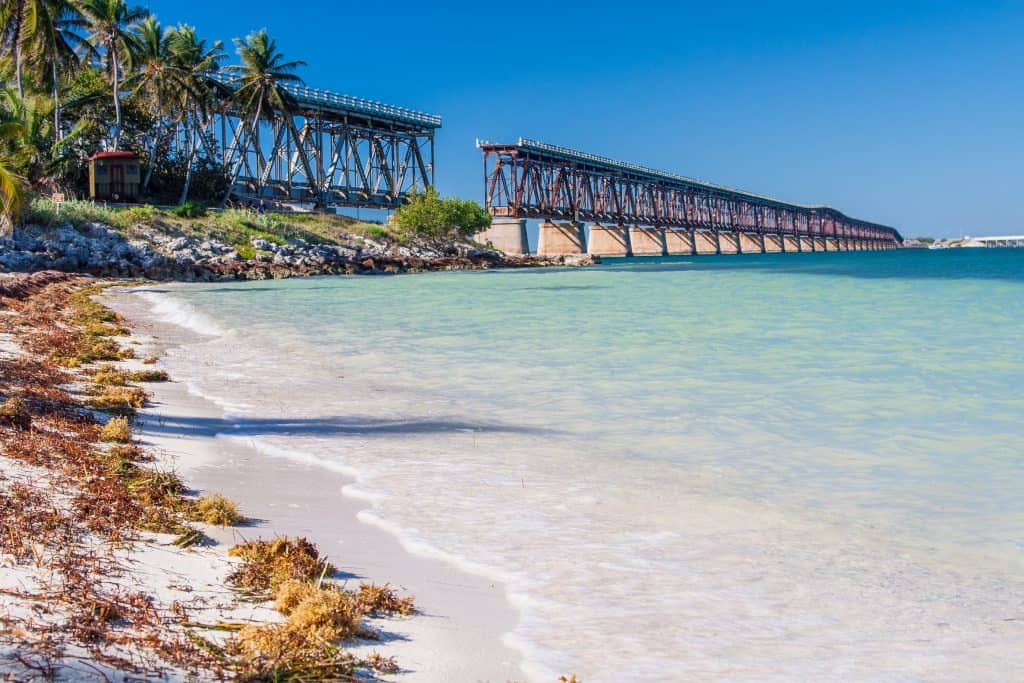
Anhinga Trail (Everglades)
For most visitors, the Anhinga Trail is one of the first glimpses they’ll get of the Everglades National Park. Very close to the Royal Palm Visitor Center, the Anhinga Trail is one of the Everglades’ best attractions.
Just short of a mile, the Anhinga Trail is one of the most accessible in the Everglades, even for novice hikers. Children and dogs are permitted, but parents are encouraged to keep a close eye as predators are nearby.
The Anhinga Trail is one of the best places to see wild alligators. A haven for all Everglades wildlife, you’ll find cormorants, egrets, herons, and roseate spoonbills along the stone wall and trees.
Look for odd-looking clusters of trees! These are pond apple trees that bear fruit. Don’t eat the apples though. They taste like turpentine. If you visit during the summer months, you might see sprays of orchids in the branches.
The path will eventually turn into a boardwalk and later into a larger observation area over the slough. You’ll see alligators drifting through the inky water as well as miles of sawgrass prairies.

Prairie Paynes Loop Trail (Gainesville)
Between Micanopy and Gainesville, the Paynes Prairie Preserve State Park protects a massive natural basin. One of the best trails. for hiking in Florida, get ready to enjoy the “great Alachua Savannah.”
Here, bison and wild horses roam free in the state’s largest grassland at 22,000 acres. At times, the fields are covered in wildflowers. In the wet season, the prairie may become a massive lake.
If it’s your first time, visit the South Rim first. From here, the Wacahoota Trail takes you through a hardwood hammock with gorgeous Southern magnolias. From the top of the observation tower, you can watch the wild horses and bison graze.
Head back to the picnic area near the visitor center to find the Cones Dike Trail. Here you’ll ramble about the open savanna. This is a perfect place to see wild alligators sunning themselves on the banks of the dike.
Eventually, you’ll connect with the Chacala Trail, perfect for a day hike. Also open to cyclists and equestrians, you’ll enjoy the uplands as the trail loops back around to the visitor center where you started your journey.

Little Manatee River Hiking Trail (Wimauma)
Wimauma holds one of Florida’s best kept secrets. Developed by the Suncoast Chapter of the Florida Trail Association, the Little Manatee River Hiking Trail is one of the best trails for hiking in Florida, their masterpiece.
On the Little Manatee River Hiking Trail, the river bluffs and creek bottoms provide excellent scenery. you’ll love climbing through the water-carved landscapes. With options between a 6.5 mile trek or a 3 mile loop, you’ll want to avoid the weekends here, they’re especially busy.
As signs welcome you to the Little Manatee River State Park, follow the fence line until it makes a left into the forest. Loblolly bay trees shade the boardwalk and ferns poke through the boards.
When the trail forks, stay right. Look for plump blackberries in open areas during April. You’ll eventually reach a thicket of wax myrtle and red maples. Watch out for poison ivy here.
When you reach the “Cross Trail” sign, you can either fork left to loop back or fork right to continue onto the creek. After another mile and a half to the right, the trail sharply descends into a floodplain for the creek. The view from the bridge is unbeatable.
When you’ve finished your trek through the scrub and flat pine forest, you’ll emerge at the Little Manatee River. The trail continues along the river before looping back to the parking area.
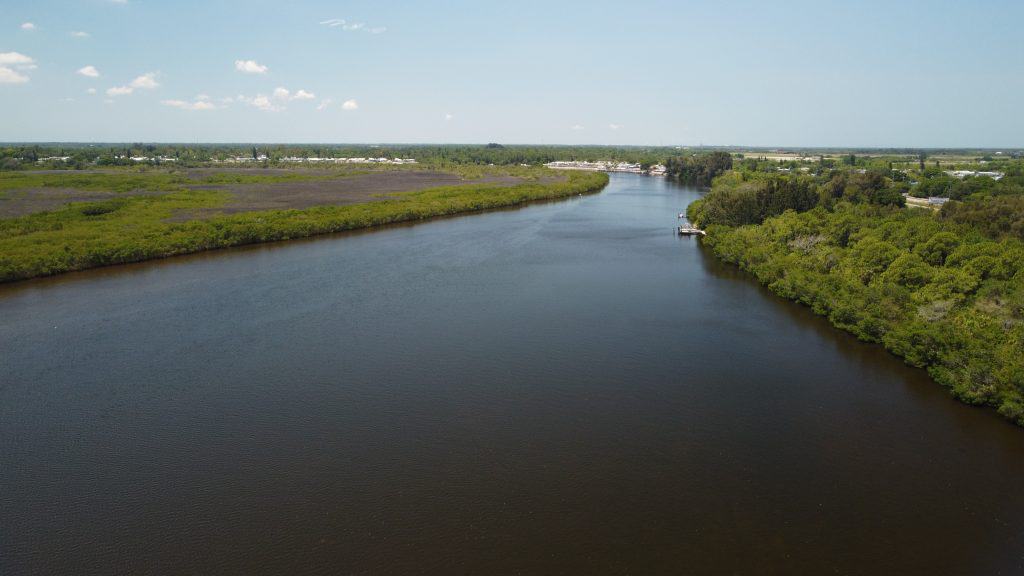
Falling Waters Sinkhole Trail (Chipley)
Did you know that Florida has waterfalls? In Chipley, found in the panhandle, you’ll find a 73-foot stunning waterfall made of natural sinkholes.
You can experience the natural phenomenon on one of the best hiking trails in Florida. You’ll find the trail easily, reaching the junction atop a bluff at a split-rail fence. Turn left to start down the trail.
The sides of each sinkhole are filled with leaves. You’ll find most of the sinkholes are surrounded by the boardwalk, but the one on the far left has a massive Southern magnolia hovering above.
Now, head down the boardwalk to take the descent into Falling Waters Sink, the crown jewel of the park. The falls were once home to a grist mill during the Civil War and later, a distillery.
When you’ve had your fill, climb back up the staircase to follow the trail to a small lake that feeds the waterfall. A bit later on, you’ll find the swimming area!
Next to the swimming hole, you’ll stumble onto the campgrounds. If you’re not staying there, this is the point to turn back. On your return, linger and enjoy the sights one last time: they’re rare in Florida.
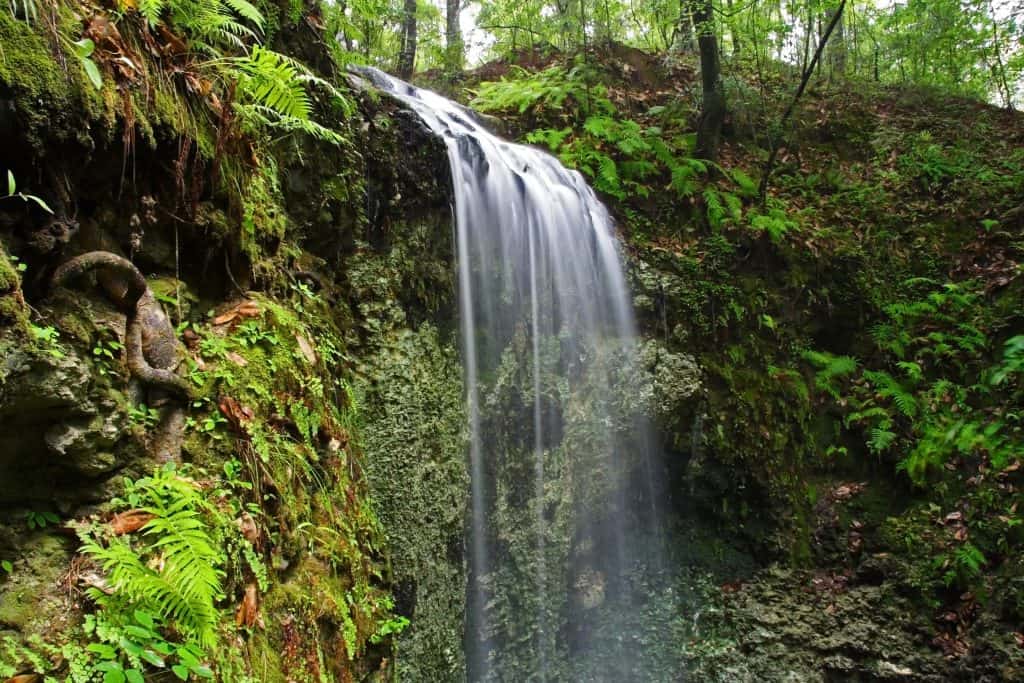

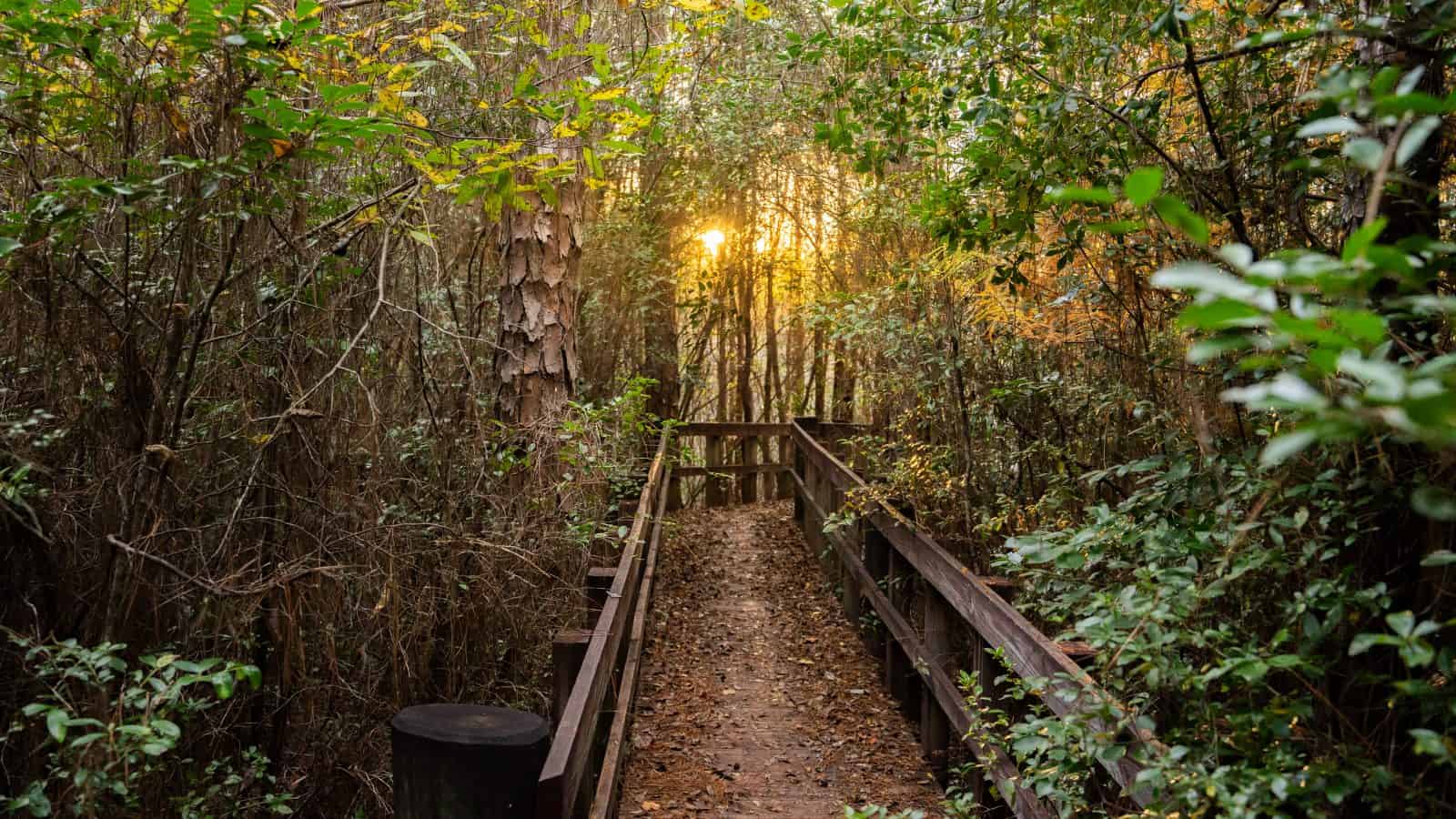
 14 Best Clearwater Beach Hotels For All Budgets
14 Best Clearwater Beach Hotels For All Budgets